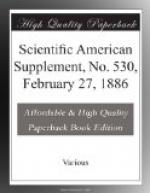It is known that when wool is treated with the sulphuric acid of commerce or in strong dilute sulphuric acid, the surface scales of the fiber are liberated at one end, and appear, under a low power, as hairs proceeding from the body of the fibers. Wool may remain thus saturated in the acid for several hours, without appearing to undergo any further change, as far as is revealed by the microscope. When treated in mass in a bath of sulphuric acid, strength 60 deg. B., for several minutes, and afterward quickly washed in a weak solution of soda, and finally in pure water and dried, it feels rough to the fingers, owing to the separation of the scales. I have preserved a small quantity of wool thus treated for the last twelve years, my object being to ascertain whether the chemical action to which it was exposed would impair its strength. As far as I can observe, without the aid of the proper tests, it seems to have retained its original tenacity. Wool thus treated seems to possess the property of resisting the ravages of the larvae of the moth. This specimen, although openly exposed for the period named, suffered no injury from them. Under the microscope, the lubrications appear to have resumed their natural position, and appear finer.
From these experiments it would seem not improbable that a new article of commerce might be produced from wool thus treated, considering that it seems to be moth-proof.
I find in practice that when sable brushes are washed in a weak solution of pure phenic alcohol and afterward in warm water, the moth worm will not eat them. In this way I preserve sable brushes. I mention this chemical fact because it shows that a change of this material is brought about by the phenol as to its edibility, and this may explain why wool treated with sulphuric acid is rendered moth-proof.
I find that when brain matter has been subjected to a solution of weak phenic alcohol, weak alkaline solutions afterward applied fail to separate its nerve-cells on the process of maceration. (This is probably owing to its albuminoids being coagulated by the action of the phenol.) When brain matter is subjected to a weak solution of soda alone, the nerve-cells are easily separated by maceration, and well adapted for microscopic use.
TESTS OF DYED BLACK SILK.
The fibers of dyed black silk may be viewed with interest under the microscope. If a few threads of its warp are placed on a glass slide, and one or two drops of concentrated nitric acid placed in contact with them, the black color changes first to green, then to blue; a life-like motion is observed in all the fibers; they appear marked crosswise like the rings of an earthworm; the surface of each fiber appears loaded with particles of dyestuff; finally the fibers wholly dissolve in the acid. If we now treat a few threads of the weft in the same manner, a similar change of color takes place. When the fibers assume




